Sukhoi S-37 "Berkut" (Golden Eagle)
(Version 2.00 - Last updated: 10/22/02)
- Background and RPG Statistics by Kenneth
Olson
- Artwork by Ted Nomura, Pat Kelley, Pat Thornton, Katie Gillette,
Ben Dunn
- Published in Antarctic Press Robotech
BACKGROUND
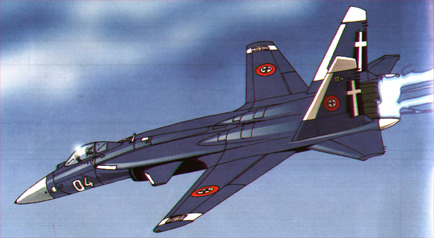
The Sukhoi S-37 is an extremely maneuverable fighter using thrust vectoring and
an innovated reverse canard design. The S-37 was originally produced
during the Global Civil War of the mid 1990's to replace Eastern Co-Prosperity
Sphere (ECPS) MIG-29 and SU-27 aircraft and combat the newly introduced
F-203 Dragon II fighter.
Fortunately for the Western Alliance, difficulties in producing the carbon fiber
and AL-Li alloy frame and the powerful Saturn/Lyu'ka vectorable turbo fan
engines allowed the ECPS forces to field only 5 squadrons of 12 aircraft a
piece.
Soon after the crash of the SDF-1, EBSIS intelligence agents were able to
acquire key technologies from the crash site which allowed for mass production
of the S-37. The Berkut soon proved itself to be an extremely adept air-superiority
fighter. Within the first year, Sukhoi S-37's were flying combat missions against the
then independent Ukrainian government. The Sukhoi-37's were met in combat against
older conventional MIG-25, MIG-29's and F-16 fighters which proved to be one
sided as EBSIS forces quickly gained air-superiority and took a large portion of
Ukraine before a UEG cease fire was brokered on 29-July 2008.
For much of the First Robotech War the S-37 saw little combat action,
as the EBSIS forces tried to stay out of the fray; however, the eventual
bombardment of the Earth by Zentraedi forces in 2011 destroyed nearly 80% of the
entire EBSIS airforce. Although EBSIS industry was shattered by the
bombardment, new models of the S-37 were rolling off the reconstituted
production lines outside the Ural Mountains six months later. By the beginning of the Second
Robotech War the EBSIS airforce had 1,729 Sukhoi-37's, roughly equal to that of the
end of the first. Once again the EBSIS forces tried to stay out of the Second
Robotech War as much as possible to save themselves for the battle with the ASC that they
were sure to come at the war's conclusion.
After the end of the Second Robotech War in August 2030, the ASC were in
such a depleted state that the EBSIS state had became the dominate power on the
planet without a shot fired.
On 1-March 2033 EBSIS forces crossed into Germany thus beginning the Second Global
Civil War. Sukhoi-37's were among the first combat aircraft into United
Earth Government airspace and finally meeting veritech mecha in combat. Although the Sukhoi's did not perform as well
against the veritech fighters as the EBSIS high command would have liked, the numerical
superiority soon proved to be the decisive factor. EBSIS forces quickly established air-superiority
and looked to take over all of Europe. However their plans soon came undone, when
the Invid attacked on 15-March 2033 routing most of the EBSIS forces and completely
destroying all of their conventional aircraft.
RPG STATS
- Vehicle Type: Sukhoi S-37 "Berkut"
- Class:
- One Man All-Weather Multi-role Fighter
-
Manufacturer: Eastern Block Soviet Independent State
Crew: One pilot wearing Tactical Life Support System
- Service History:
-
S-37: Served with the Former Soviet Union and Eastern Block Soviet
Independent States from 1997 until 2025
MDC BY LOCATION:
| Location |
Berkut |
| 1 Main Body |
100 |
| 1 Reinforced Pilots Compartment |
50 |
| Engine Thrusters (2) |
25 |
| Forward Canards (2) |
5 |
| 2 Wings (2) |
50 |
| 2 Tails (2) |
15 |
NOTES:
- Destroying the MDC of the main body or the Pilots Compartment will destroy the mecha
- Destruction of either of the wings or tails will send the Berkut into and uncontrollable spin
SPEEDS:
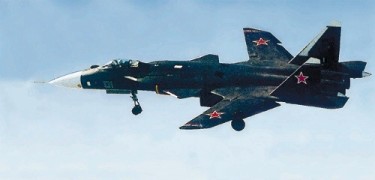 MAXIMUM SPEED:
MAXIMUM SPEED: - Sea Level: 760 kts (1400 kph)
- At Altitude (10,000 m): 1,350 kts (2,500 kph)
- CRUISE SPEED:
- 500 kts (926 kph)
- STALL SPEED:
- 100 kph
- CLIMB RATE:
- over 13,800 m per minute
- CEILING:
- 19,000 m
- TAKE-OFF RUN:
- 1200 m
- LANDING RUN:
- 400 m
- RANGE:
- Normal: 3880 km
- Maximum: 4,200 km
- Ferry: 7,000 km
- Low Altitude: 1,000 km
- DESIGNED G LIMITS:
- +10.0/-5.0
-
STATISTICAL DATA:
- HEIGHT:
- 6.3 m
- WINGSPAN:
- 15.2 m
- LENGTH:
- 22.0m
- WEIGHT:
- Empty: 24,000 kg
- Max T-O: 34,000 kg
- CARGO:
- Small compartment behind pilot's seat for personal belongings
- MAX ENGINE THRUST
- [MAIN] 2 x SATURN/LYU'KA TURBOFAN AL-37 FU: With
Afterburning thrust-vectoring pitch from ±20º
at 30º degrees per second. Each engine is rated at 84 kN (dry) or 142.2
kN with afterburning.
- FUEL CAPACITY:
- Normal: 7,000 kg
- Maximum: 10,000 kg
-
WEAPON SYSTEMS:
-
 1 x
GSH-6-30 SIX BARRELED 30 MM AUTOCANNON: A single 30mm autocannon is mounted
on the right hand side of the S-37. The cannon can fire at a
rate of 6,000 rounds per minute with an initial bullet speed of 851 m/s.
The cannon is capable of firing up to 6,000 rounds per minute with a muzzle
velocity in excess of 950 meters per second. The cannon is fed from an
internal 500 round storage drum which feeds the cannon with a double-ended
hydraulically driven linkless feed
system.
1 x
GSH-6-30 SIX BARRELED 30 MM AUTOCANNON: A single 30mm autocannon is mounted
on the right hand side of the S-37. The cannon can fire at a
rate of 6,000 rounds per minute with an initial bullet speed of 851 m/s.
The cannon is capable of firing up to 6,000 rounds per minute with a muzzle
velocity in excess of 950 meters per second. The cannon is fed from an
internal 500 round storage drum which feeds the cannon with a double-ended
hydraulically driven linkless feed
system.
- PRIMARY PURPOSE: Assault
- SECONDARY PURPOSE: Anti-Mecha
- RANGE: 1500m
- DAMAGE: 3D6 per short burst (10 rounds), 5D6 per long burst (25
rounds)
- RATE OF FIRE: Single shots or bursts equal to the combined attacks of the pilot.
- PAYLOAD: 500 rounds of internal ammunition or 50 short bursts
or 20 long bursts.
- NOTES: Critical strikes against conventional
aircraft on 19 or 20
- 8 x BODY/WING HARD POINTS: Four fixed hard point are mounted
under the fuselage and two on each of the wings (if necessary). Each of
the hard points can mount a single AA-10, AA-11, or AA-12 missile or if
necessary up to 2,000 kg (for each under fuselage hardpoint) or 1,000 kg (for
each wing hardpoint) of ordinance.
-
 AA-10
ALAMO (R-27): The AA-10 "Alamo" was a contemporary of the American
Sparrow AIM-7M missile. The missile is equipped with a semi-active
radar homing head; although, several variants using passive IR and active RF
are known to exist. The AA-10 was used extensively by Russian and
Eastern Coprosperity forces during the Global Civil War; however, the
missile was gradually phased out by the AA-12 in the early 21st century.
AA-10
ALAMO (R-27): The AA-10 "Alamo" was a contemporary of the American
Sparrow AIM-7M missile. The missile is equipped with a semi-active
radar homing head; although, several variants using passive IR and active RF
are known to exist. The AA-10 was used extensively by Russian and
Eastern Coprosperity forces during the Global Civil War; however, the
missile was gradually phased out by the AA-12 in the early 21st century.
- PRIMARY PURPOSE: Anti-aircraft
- MISSILE SPEED: 3,000 kph
- RANGE: 80 km
- GUIDANCE: Semi-active radar
- DAMAGE: 2D6*10
- BLAST RADIUS: 40 feet
- RATE OF FIRE: One Missile
- STRIKE BONUS: +2 to strike
-
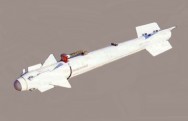 AA-11
ARCHER (R-73): The premier short range all-aspect IR missile
of the former Soviet Union, Eastern Co-Prosperity Sphere Forces and EBSIS.
The missile is directly connected to the pilot's helmet which allows
engagements lateral to the aircraft.
AA-11
ARCHER (R-73): The premier short range all-aspect IR missile
of the former Soviet Union, Eastern Co-Prosperity Sphere Forces and EBSIS.
The missile is directly connected to the pilot's helmet which allows
engagements lateral to the aircraft.
- PRIMARY PURPOSE: Anti-aircraft
- MISSILE SPEED: 2,000 kph
- RANGE: 40 km
- GUIDANCE: All aspect infrared
- DAMAGE: 1D6*10
- BLAST RADIUS: 30 feet
- RATE OF FIRE: One missile
- STRIKE BONUS: +3 to strike
- AA-12 ADDER (R-77): A Russian missile similar to the
American AIM-120 AMRAAM missile. The AA-12 is inertially guided to the
target from launch through mid-course and terminally guided by its own
onboard active RF seeker. The AA-12 missile was introduced during the
global civil war of the mid 1990's and became the premier medium range
missile for the Eastern-Co-Prosperity Sphere Forces.
- PRIMARY PURPOSE: Anti-aircraft
- MISSILE SPEED: 3,000 kph
- RANGE: 100 km
- GUIDANCE: Inertial with terminal active radar
- DAMAGE: 2D4*10
- BLAST RADIUS: 35 feet
- RATE OF FIRE: One missile or in volleys of two
- NOTES: +4 to strike
- 2 x CHAFF/FLARE DECOY DISPENSERS: Two chaff flare decoy dispensers
are located in the rear of the aircraft. Each dispenser can hold up to
30 decoys apiece with the standard load out consisting of 50% chaff
bundles and 50% flares. The type and number of each decoy is triggered
manually by the pilot.
- PRIMARY PURPOSE: Anti-missile
- RANGE: 100 m
- RATE OF FIRE: Up to 10 decoys per attack
- PAYLOAD: 30 decoys per dispenser
- NOTES: In game play only chaff bundles will
affect RF missiles and flares affect IR missiles. The player must
declare after the missile strike, without knowledge of the natural strike
roll of the missile attack, which type of decoy he is deploying.
For each effective decoy deployed subtract -3 from the natural die roll
for dumb missiles (those with strike rolls +2 or less), -2 from the
natural die from for standard missiles (+3 to strike), -1 from the natural
die roll from intelligent missiles (+4 or greater to strike). If the
natural die roll, with out any strike bonuses added falls below +5 then
the decoys are effective and the missile(s) will miss their intended
target.
STANDARD EQUIPMENT FOR THE BERKUT:
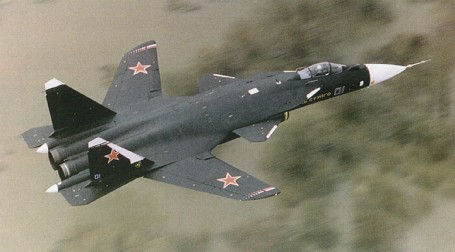 ACTIVE SENSOR JAMMER
SORBTSYS-S (L-006): Internal ECM providing broadband
protection. Estimated system effective radiative power 30 dBW.
ACTIVE SENSOR JAMMER
SORBTSYS-S (L-006): Internal ECM providing broadband
protection. Estimated system effective radiative power 30 dBW.- AUTO-PILOT: The Berkut is equipped with a computerized auto-pilot, allowing the
pilot to relax or even sleep during long voyages. The auto- pilot can be programmed with a
single destination or a complex flight plan involving multiple speeds, directions, and
destinations. The onboard computer will alert the pilot when the fighter is near its
destination, and can also be set to automatically signal when sensors detect objects near
the fighter.
- CHAFF AND FLARE DISPENSERS
APP-55: 30 chaff and 30 flares in two dispensers located in the rear
of the aircraft, see entry above for further details.
- COMBAT COMPUTER WITH HUD DISPLAYS: The combat computer tracks and identifies specific enemy
targets and displays them on a heads up display. The radar and combat
computer can identify and track up to 50 targets simultaneously and engage
with semi-active missiles up to 4.
- INFRARED SEARCH AND TRACK TARGETING SYSTEM: The Berkut
mounts a forward looking infrared search and tracking targeting system in a
small housing immediately ahead of the windshield and laser ranging system.
The system can be used to engage inbound targets when use of the radar is
prohibited because of restricted use of radar emissions. The system has
a range of 30 km and while in use the aircraft retains its strike bonus.
- INFRA-RED WARNING RECEIVER MIKOYAN IR-8 (IRWR):
Providing rear aspect protection from IR guided missiles
- LASER TARGETING SYSTEM: System has a range of 50 km and is
used to increase the accuracy of onboard weapons.
- RADAR PHAZOTRON ZHUK 27 X-BAND PULSE DOPPLER: Detection radar
against 0 dBsm target 80 km. The radar has limited multi-targeting
capability being able to track up to 50 targets but can engage only 4 at any
given time.
- RADIO/VIDEO COMMUNICATION: Long range, directional communications system with
satellite relay capabilities. Range: 300 miles (960 km) or can be boosted indefinitely via
satellite relay.
- RADAR-ABSORBING SKIN COVER: The Berkut is covered with RF
absorbing material which reduces the aircrafts passive radar cross section.
- RADAR WARNING MIKOYAN YR-7 (RWR): Providing all
aspect broadband protection from RF guided missiles.
- STANDARD SURVIVAL KIT: All EBSIS fighters come equipped with a portable survival
kit. Inside the small reinforced box is a medium-sized flashlight, two hand flares, one
rocket flare, a compass, infrared distancing binoculars, a small mirror, a pocket knife,
dehydrated and concentrated food (can be stretched into a five day supply for one person)
and basic first aid items (aspirin, bandages, disinfectants, etc.)
- TACTICAL LIFE SUPPORT SYSTEM: The Berkut cockpit is pressurized, and also
provides additional air feeds to the pilot's flight suit that provides him with
pressurized breathing. The EBSIS flight suit also contains an upper and lower g-suit that
promotes blood circulation even during high-g turns, thus decreasing the possibility of
pilot's blacking out in combat.
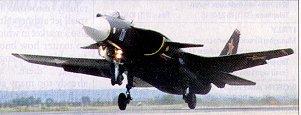 COMBAT BONUSES FOR BERKUT TRAINING:
COMBAT BONUSES FOR BERKUT TRAINING:
- 2 attacks per melee (plus those of the pilot).
- Add one additional action/attack at levels six and eleven.
- +1 to strike
- +7 to dodge
Random Hit Locations
When there is an equal chance of hitting both sides from 1D6
- 1-3 hits the right side
- 4-6 hits the left
When there is a preferred side, roll 1D10
- 1-8 hits the preferred side
- 9-10 hits the opposite side
| S-37 |
FRONT |
BACK |
SIDES |
TOP |
BOTTOM |
| Main Body |
01-25 |
01-30 |
01-30 |
01-35 |
01-35 |
| Pilot's Compartment (Main Body) |
26-55 |
31-40 |
31-50 |
36-55 |
36-55 |
| Engine Thrusters (Main Body |
- |
41-65 |
51-60 |
56-60 |
56-60 |
| Forward Canards (Main Body) |
56-65 |
66-70 |
61-65 |
61-65 |
61-65 |
| Wings (Main Body) |
66-90 |
71-85 |
66-87 |
66-92 |
66-00 |
| Tails (Main Body) |
91-00 |
86-00 |
88-00 |
93-00 |
- |
REFERENCES USED IN THIS DESIGN
Back to Mecha Home
 1 x
GSH-6-30 SIX BARRELED 30 MM AUTOCANNON: A single 30mm autocannon is mounted
on the right hand side of the S-37. The cannon can fire at a
rate of 6,000 rounds per minute with an initial bullet speed of 851 m/s.
The cannon is capable of firing up to 6,000 rounds per minute with a muzzle
velocity in excess of 950 meters per second. The cannon is fed from an
internal 500 round storage drum which feeds the cannon with a double-ended
hydraulically driven linkless feed
system.
1 x
GSH-6-30 SIX BARRELED 30 MM AUTOCANNON: A single 30mm autocannon is mounted
on the right hand side of the S-37. The cannon can fire at a
rate of 6,000 rounds per minute with an initial bullet speed of 851 m/s.
The cannon is capable of firing up to 6,000 rounds per minute with a muzzle
velocity in excess of 950 meters per second. The cannon is fed from an
internal 500 round storage drum which feeds the cannon with a double-ended
hydraulically driven linkless feed
system.  AA-10
ALAMO (R-27): The AA-10 "Alamo" was a contemporary of the American
Sparrow AIM-7M missile. The missile is equipped with a semi-active
radar homing head; although, several variants using passive IR and active RF
are known to exist. The AA-10 was used extensively by Russian and
Eastern Coprosperity forces during the Global Civil War; however, the
missile was gradually phased out by the AA-12 in the early 21st century.
AA-10
ALAMO (R-27): The AA-10 "Alamo" was a contemporary of the American
Sparrow AIM-7M missile. The missile is equipped with a semi-active
radar homing head; although, several variants using passive IR and active RF
are known to exist. The AA-10 was used extensively by Russian and
Eastern Coprosperity forces during the Global Civil War; however, the
missile was gradually phased out by the AA-12 in the early 21st century.
 AA-11
ARCHER (R-73): The premier short range all-aspect IR missile
of the former Soviet Union, Eastern Co-Prosperity Sphere Forces and EBSIS.
The missile is directly connected to the pilot's helmet which allows
engagements lateral to the aircraft.
AA-11
ARCHER (R-73): The premier short range all-aspect IR missile
of the former Soviet Union, Eastern Co-Prosperity Sphere Forces and EBSIS.
The missile is directly connected to the pilot's helmet which allows
engagements lateral to the aircraft.
 ACTIVE SENSOR JAMMER
SORBTSYS-S (L-006): Internal ECM providing broadband
protection. Estimated system effective radiative power 30 dBW.
ACTIVE SENSOR JAMMER
SORBTSYS-S (L-006): Internal ECM providing broadband
protection. Estimated system effective radiative power 30 dBW. COMBAT BONUSES FOR BERKUT TRAINING:
COMBAT BONUSES FOR BERKUT TRAINING: